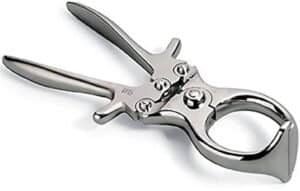
Castration in sheep and goats is a common management practice performed for various reasons. It is done for improving meat quality, controlling breeding, and reducing aggressive behaviors. There are Several methods of Castration in sheep & goats depending on the age of the animal, resources available, and preferences of the farmer or veterinarian.
- Surgical Castration Procedure –
The scrotum is cleaned and disinfected before surgery
A scalpel or sterile blade is used to make an incision in the scrotum to expose the testicles.
The testicles are removed, and the spermatic cords are either tied off (ligated).
Advantages of Surgical Castration
- It is Permanent and effective.
- It is useful for older animals when testicles are too large for other methods.
Disadvantages of Surgical Castration
There is Risk of infection and bleeding.
It requires proper training or veterinary assistance.
It is Painful & may requiring proper pain management.
Procedure –
A strong rubber band is placed around the base of the scrotum using an elastrator tool. Rubber band, cuts off blood supply to the testicles.
The testicles and scrotum dry up and fall off within 1–2 weeks.
Advantages of this method
It is Simple and inexpensive.
It can be performed on young animals with minimal tools.
Disadvantages:-
This method is only suitable for animals under 2–3 weeks old (due to smaller scrotal size).
There may be Potential for discomfort and complications, such as infection or tetanus.
Procedure –
-A burdizzo castrator is used to crush the spermatic cords without making an incision.
This cuts off blood flow to the testicles, leading to their atrophy of testicles
Advantages of Burdizzo Method of castration
– Method is Bloodless method with minimal risk of infection.
It Can be used on slightly older animals compared to the rubber band method.
Disadvantages of this method
It equires proper technique to ensure effectiveness.
It is Painful without anesthesia or sedation.
- Chemical Castration
Procedure of Chemical Castration
In this method Chemicals (e.g., calcium chloride or zinc gluconate) are injected into the testicles to destroy the testicular tissue.
Advantages –
It is minimally invasive.
Method is suitable for young animals.
Disadvantages –
There is risk of improper injection and complications.
Effectiveness may vary.
This method is not widely practiced due to limited availability in some regions.
- Hormonal Method of castration
Procedure of hormonal Method of castration
In this method hormonal implants or injections are used to suppress testosterone production and reproductive function.
Advantages of the method –
It is reversible in some cases.
It educes aggression and sexual behavior without surgery.
Disadvantages:-
It requires periodic administration of drug
Method is costly and less practical for most farm settings.
Factors to Take into Account for all Methods
Age of the Animal- Earlier castration (2–8 weeks old) is generally recommended as it is less stressful and reduces complications.
Pain Management – Use of local anesthetics, analgesics, or sedation is recommended for humane handling.
Hygiene – Proper cleaning and disinfection is essential to minimize infection risks.
Tetanus Prevention – Vaccination against tetanus is essential in methods like elastration or surgical castration.Choosing the right method depends on age, availability of skilled personnel, and legal or ethical considerations in the region.

